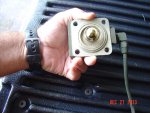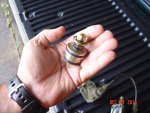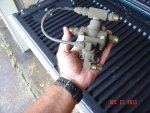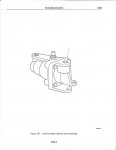What an adventure it has been troubleshooting the brakes in my 923A2. When I first noticed the leak I wanted someone here to give me a quick answer to the problem so I could hurry up and get back on the road. A glad hand leak was suggested so I hoped that was it because it would be quick and easy. Then after listening to other suggestions I was convinced that it was a torn diaphragm in one of the chambers. It made sense because that would vent to the snorkel, which is where I heard the noise from the leak.
So I started studying the TM's really hard. I learned all about the wedge brakes that these have, and the function of the primary, secondary and spring brakes. I learned about caging the spring brakes and was prepared to change the diaphragm even if it was on one of the piggybacked chambers.
So on Saturday, with the help of my granddaughter, I started out to determine which of the chambers was leaking. I methodically took each vent line loose from the chambers one or two at a time and had her step on the brakes. We checked each and every one of them and they all tested good........figure that.
So then I found which line going in to the intake tube is the brake vent line by listening and feeling while she held the brake down. Then I took each of the lines loose one at a time from the tee in the line about 2' away from where the line goes in to the intake. I found that the leaking air was coming from a line that went to the front of the truck. So I figured I must have mis-diagnosed a leak in one of the front chambers. But I decided to trace the line to where it went, which was not easy. My truck was rebuilt at the Blount Island Depot and everything was painted green, including all of the bundles of wires and hoses.
I then found that the vented air was coming from the front limiter/release valve that is mounted on a bracket attached to the frame cross member about 1' behind the front bumper. By taking the lines loose from the valve I determined that the valve had to be bad. So I took the valve apart and found a nylon ball that seats in the valve was broken.


So I studied some more. I found that the valve that I had does not match the valve shown in the TM for my truck.


This made me wonder why did someone put the wrong valve in my truck. So then I read the TM about the retrofit of the ABS in these trucks. These did not originally come with ABS, it was added later. There I found that the valve was changed during the retrofit to the Bendix LQ-2 valve to apply 67% of the braking pressure to the front brakes to balance the system for the ABS.
As bad as I wanted to have my truck on the road now, I could not find it anywhere within a 150 mile radius from here. So I ordered a new one off of Epay for about $28. It will be in this week and I'll be back on the road and smiling again.
A few good things came from this adventure:
1. The willingness of those on this website to help out and share their knowledge was confirmed.
2. I now have a really good understanding of the brakes on my truck. I don't know every valve and tee, but I do know my way around in the system.
3. My grandbaby knows the difference in a 3/4" and a 13/16" wrench.
Thanks to all for the help and support.







